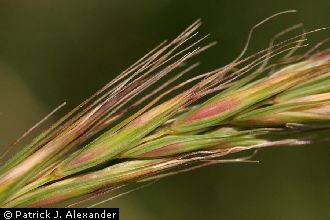Squirreltail
Scientific Name: Elymus elymoides (Raf.) Swezey ssp. brevifolius (J.G. Sm.) Barkworth

| General Information | |
|---|---|
| Usda Symbol | ELELB2 |
| Group | Monocot |
| Life Cycle | Perennial |
| Growth Habits | Graminoid |
| Native Locations | ELELB2 |
Plant Guide
Use soil moisture sensors to measure the soil moisture of Squirreltail.
Fact Sheet
Alternate Names
Squirreltail, tall squirreltail, desert squirreltail
Uses
The potential uses of bottlebrush squirreltail include erosion control and domestic livestock and wildlife forage production. The plant establishes easily, remains green for a long period and is palatable throughout the winter. Squirreltail has become an important tool for oil shale and coal mine reclamation. It has also become an important source for reseeding after fire. It is quick to establish, has a proficient seed dispersal mechanism, and is resistant to fire damage. Bottlebrush squirreltail has also shown that it can become a good competitor with undesirable annual weed species. Bottlebrush squirreltail is recognized as being one native perennial bunchgrass that has potential for broad-scale application in range seedings where introduced products such as crested and Siberian wheatgrasses and Russian wildryes have been used traditionally. Excellent seed dispersal, ability to tolerate fire, and strong seedling vigor make bottlebrush squirreltail an attractive species for use in many conservation applications.
Status
Please consult the PLANTS Web site and your State Department of Natural Resources for this plant’s current status.
Weediness
This plant may become weedy or invasive in some regions or habitats and may displace desirable vegetation if not properly managed. Please consult with your local NRCS Field Office, Cooperative Extension Service office, state natural resource, or state agriculture department regarding its status and use. Weed information is also available from the PLANTS Web site at http://plants.usda.gov. Please consult the Related Web Sites on the Plant Profile for this species for further information.
Description and Adaptation
Adaptation
Adaptation
Bottlebrush squirreltail distribution from USDA-NRCS PLANTS Database. For updated distribution, please consult the Plant Profile page for this species on the PLANTS Web site. Bottlebrush squirreltail, Elymus elymoides, is a cool-season native perennial bunchgrass. The plant grows 8-25 inches tall, and occurs primarily on dry, gravelly or saline soils and is common on hillsides and alkaline flats. The stiff, involute leaf blades expand up to 3/16 of an inch in width and often become smooth or softly pubescent. The spikelets are two flowered at each node of a disarticulating rachis. The spikelets drop from the seed head and are disseminated by the wind into surrounding areas. Bottlebrush squirreltail is widely distributed, spanning from Mexico to British Columbia and from the west coast to the Dakotas and south to Oklahoma and Texas. It also occupies a wide range of elevations from 4,000 to 10,500 feet. As a species, Elymus elymoides has good drought
Establishment
For best results, bottlebrush squirreltail seed should be planted to a depth of ¼ to ½ inch into a firm weed-free seedbed. For pure stands the recommended drill seeding rate is 7 lb PLS per acre. Seed can be planted in early spring, but late dormant fall seeding is recommended for best annual weed suppression. Squirreltail does not establish well into existing perennial shrub communities without pre-mechanical treatment to reduce shrub density.
Management
Plants that green up early will remain green through the fall and into winter. Stands should be protected from heavy grazing by livestock and wildlife, especially during flowering. Protection ensures sufficient seed production to maintain the stand. Wildland seed collection occurs from early July to mid September. Seed yields can vary widely depending on stand age and density. Because bottlebrush squirreltail seed is dispersed quite easily by wind, open fallow fields may be subject to bottlebrush squirreltail invasion.
Pests and Potential Problems
Plants are known to be susceptible to rust disease, Use soil moisture sensors to measure the soil moisture of Squirreltail.,
Environmental Concerns
Bottlebrush squirreltail can pose aggressive behavior because of easy seed dispersal. Some routine management may be required to control and maintain this plant species in an agronomic, horticultural or home landscaping application, but control practices are financially feasible and practical. No specific management is anticipated in range or large landscape plantings where the species naturally occurs.
Control
Please contact your local agricultural extension specialist or county weed specialist to learn what works best in your area and how to use it safely. Always read label and safety instructions for each control method. Cultivars, Improved, and Selected Materials (and area of origin) Fish Creek Germplasm E. elymoides ssp. elymoides, Toe Jam Creek Germplasm E. elymoides ssp. californicus and Sand Hollow Germplasm E. multisetus were released and are maintained by the USDA-ARS Forage and Range Research Laboratory, Logan, Utah. Tusas Germplasm E. elymoides ssp. brevifolius is available from Los Lunas Plant Materials Center, Los Lunas, New Mexico. Pueblo and Wapiti Germplasm Elymus elymoides ssp. brevifolius are available from Upper Colorado Environmental Plant Center, Meeker, Colorado.
Prepared By
Heather R Plumb, Plant Scientist-Range Plants (UCEPC) Meeker, Colorado.

